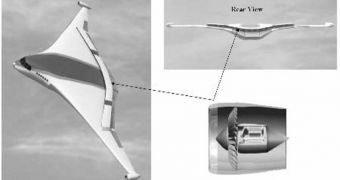The large number of passenger, cargo and military jet airplanes out there today significantly contributes to global warming and climate change. Primarily, the craft do so by burning fossil fuels and releasing significant amounts of pollution in the air, but they also create contrails. These are exhaust byproducts that linger and drift in the skies, becoming indistinguishable from clouds. They alter weather patterns, cloud and precipitation formation, which in turn promotes the devastating outcomes of the greenhouse effect, LiveScience reports.
Flight engineers have been working on methods of reducing these massive impacts that jets have on the environment for many years, but considerable breakthroughs have yet to be produced. This year saw the testing of larger, solar-powered aircraft, but they cannot lift large weights, or even carry passengers. This specific technology is still in its infancy, and, for now, applications include only spy planes, military drones, and high-altitude reconnaissance vehicles. At least a decade or two will have to pass before advancements could finally see us traveling in Sun-powered aircraft.
A recent achievement in the field of avionics was recently accomplished with the testing of a manned, all-electric aircraft. The plane flew for about eight minutes, and managed to achieve a speed of 155 miles per hour, or 250 kilometers per hour. While this was indeed a record for all-electric vehicles, it is clear that the goal of transporting hundreds of passengers in such planes is still a long way away. Scientists say that major innovations and breakthroughs are needed in many areas, before the idea of an electric jetliner can be taken seriously.
One proposal that might work came from experts at the IEEE, led by researcher Cesar A. Luongo. The group believes that one possible answer to the crisis could be the use of superconducting electric propulsion systems on future electric airplanes. The team emphasizes that this would mean the design of current planes would have to change. Rather than two to four large engines mounted under the wings, the new vehicles would have several, smaller propulsion systems embedded directly in the wings. The machines also need to be made out of lighter, stronger materials, preferably from composites. The IEEE team says that these designs are about 20 years away.

 14 DAY TRIAL //
14 DAY TRIAL //